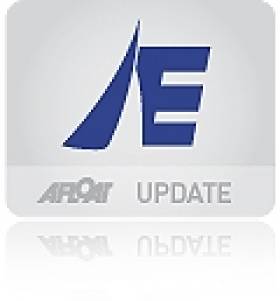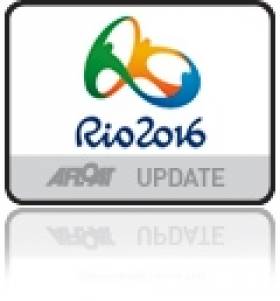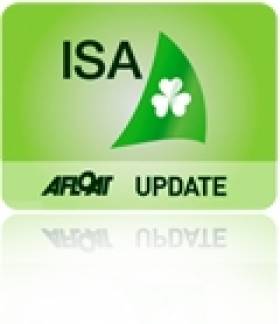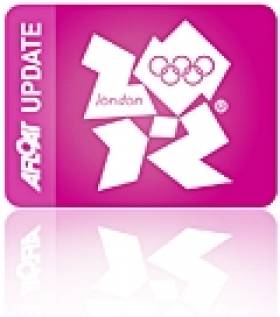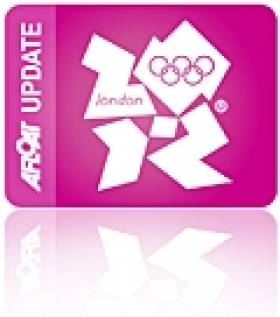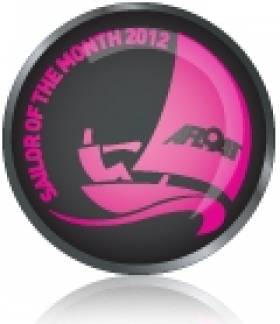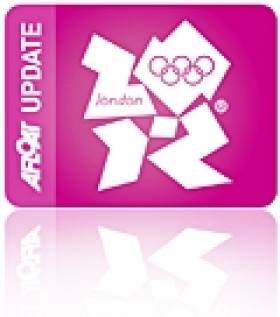Displaying items by tag: david burrows
#etchells – An eighth scored in race four of the Etchells World Championships has moved sole Irish boat, Bedrock sailed by Richard, David and Samantha Burrows, up to 27th overall in New York. Overall results are here
Bill Hardesty's resilience has brought him and his crew of Taylor Canfield, Stephanie Roble and Marcus Eagan to the top of the leader board despite a heavy downpour and fluky winds on the third day of the 2014 Etchells Worlds, hosted by the New York Yacht Club at Harbour Court in association with Sail Newport.
After a two-hour postponement on shore followed by another two hours on the water, storm clouds gathered, the wind velocity increased and the wind direction settled down enough to allow Race 5 to start. Shortly after that, the rain began, so forceful at times the weather mark was obscured. Those who sailed to the right, toward the squall, faired better and rounded the weather mark in the lead, albeit a bit wetter for their efforts. The wind shifted left throughout the race dropping slightly in velocity. Senet Bischoff and Ben Kinney won Race 5 by a healthy margin with Hardesty finishing fourth, giving him a 9-point lead over Hank Lammens, who finished 16th in today's race. Marvin Beckman sits in third overall followed by John Bertrand in fourth and Ante Razmilovic rounding out the top 5.
Today's start time has by moved up one hour tomorrow to maximize what is expected to be a dying northerly breeze. After six races have been completed, each team will be able to discard their worst finish.
The 2014 Etchells Worlds will continue until tomorrow Saturday.
#Etchells – Malahide trio David, Richard and Samantha Burrows have had a mid–fleet start to their Etchells World Championships bid in New York yesterday. The sole Irish contenders placed 66 and 26 in the first two races in the 95–boat fleet in near perfect sailing conditions off Newport, R.I. Full results here.
For two-time Etchells World Champion Bill Hardesty (San Diego) it was hard to imagine a better start to the regatta. Hardesty and his team placed second in both races and lead the regatta overall, with Ante Razmilovic's Swedish Blue team (London, U.K.) in second and defending world champion Marvin Beckmann (Houston) in third. In his first visit to Newport in more than 30 years, John Bertrand (South Yarra, Australia), the America's Cup-winning skipper of Australia II, lies fourth.
It wasn't easy for anyone, however. To spread out the fleet, principle race officer Tom Duggan stretched the legs to between 2 and 3 nautical miles, with each race taking between 90 and 120 minutes. The bulk of the fleet didn't reach the dock until after 6 p.m.
"We were physically grinding it out all day," said Taylor Canfield, who serves as tactician for Hardesty. "Finishing up with a five-leg course just made it that much more grueling. Our downwind speed was great, we gained a couple of boats every run. Then we were able to catch one or two boats on the upwind."
Hardesty, who won his world titles in 2008 and 2011, Beckmann (2013), and Bertrand (2010) are all former world champions, and their experience and poise showed today. With 95 boats on the starting line and both starts run under the black flag (which means that anyone who is over the starting line early is disqualified from the race), it was a day to limit risk and avoid large mistakes. Sailors will often say before events such as this that you can't win the regatta on the first day, but you certainly can lose it.
"The goal today was to get two single-digit finishes," said Steve Hunt, Beckmann's tactician. "We did and so we're happy."
Those teams that were not so fortunate today can take some comfort in knowing that, should the regatta schedule play out as planned, they will be able to discard their worst finish from their scoreline. But those teams with one or more disappointing finishes on Day 1 are now operating with little margin for error.
The regatta will continue tomorrow through Saturday.
2014 Etchells World Championship
Tuesday, June 24, Day 1 Preliminary Top-10 Results
(Place, Sail Number, Boat Name, Skipper, Hometown, Race 1, Race 2, Total)
1. USA 979, Line Honors, Bill Hardesty, San Diego, 2-2 4.0
2. HKG 1333, Swedish Blue, Ante Razmilovic, London, U.K., 3-6 89.0
3. USA 1378, The Martian, Marvin Beckmann, Houston, 8-3 11.0
4. AUS 1383, Triad, John Bertrand, South Yarra, Australia, 4-10 14.0
5. USA 1411, Elizabeth, Tom Carruthers, San Diego, 5-12 17.0
6. USA 1208, Gumption3, Kevin Grainger, Rye, N.Y., 6-19 25.0
7. USA 1376, Arethusa, Phil Lotz, Newport, R.I., 9-18 27.0
8. CAN 1396, Hank Lammens, Norwalk, Conn., 20/ZFP-8 28.0
9. USA 1308, KGB, Senet Bischoff & Ben Kinney, Larchmont, N.Y., 10-20 30.0
10. USA 1296, Appreciation, Jeffrey Siegal, Portsmouth, R.I., 17-17 34.0
#etchells – Ireland has a single entry in a 95–boat fleet for the 2014 Etchells keelboat World Championship from June 21 to 28 in New York. The class's 46th world championship will be one of the biggest and most competitive in its celebrated history.
Malahide and Howth Yacht Club sailing family trio, Richard, David (a four time Olympian) and Samantha Burrows are entered in the Corinthian, Masters and Seniors divisions in a fleet that has already attracted some of the world's top professional and amateur sailors.
Long Island Sound yacht designer and builder Skip Etchells created the 31-foot keelboat in 1965 hoping to win selection as the new Olympic keelboat.
The design dominated the racing in the selection trials, but lost in the onshore voting for Olympic status. For the 2016 Olympics, there will be no keelboat sailed in the Olympic regatta.
But nearly 50 years after the first Etchells touched the water, the class is as strong as ever.
The number of entries in recent class world championships has varied from 41 last year to a high of 100 in 1998.
Up to nine races are scheduled, all but one of which will count toward a team's final score. Registration and measurement for the regatta will start on Saturday, June 21, with the racing taking place on Rhode Island Sound, Tuesday, June 24, through Saturday, June 28.
For an entry list click here.
O'Leary & Burrows Could Go For Gold In Rio as Star 'Secures A Slot' UPDATED
UPDATE: The governing body for the Star class is reporting that the earlier news of its reinstatement in the Olympics for 2016 is still "just a rumour".
In a statement, International Star Class Yacht Racing Association (ISCYRA) president Bill Allen said that while the Olympic committee in Brazil "may request an 11th medal for sailing", no decision has yet been made and likely will not be made until summer at the earliest.
"The spreading of rumours concerning Olympic status does not help our position," he added, saying he would inform Star class membership with any new developments as and when they arise.
#Rio2016 - Ireland's Star sailors Peter O'Leary and David Burrows could have another shot at Olympic gold in Rio if the latest news from the IOC is to be believed.
Sailing Anarchy reports that "the ink is dry" on an agreement to secure a place for the Star class in the sailing schedule at the 2016 Olympic Games in Rio de Janeiro.
The move is thanks to a "quirk" in IOC regulations that allow the host country of any Olympic Games to add an event of their own choosing, provided the hosts cover the costs.
And with local sailing duo Robert Scheidt and Bruno Prada in the Star's top ranks - claiming the bronze in London 2012 - the return of the class certainly seems a no-brainer.
The only question remaining now is whether O'Leary and Burrows - who finished 10th in the class at Weymouth last summer - want to go for gold one more time in Rio!
Celebrate Irish Sailing At The ISA Awards Ball
#ISA - Supporters of Irish sailing are asked to come together for a night of celebration and pay tribute to some of the outstanding contributors to sailing across six categories including the Mitsubishi Motors Club of the Year, Volunteer of the Year, Instructor of the Year and Training Centre of the Year.
Irish sailing's stars of tomorrow - such as ISAF Youth Worlds silver medallist Finn Lynch - are also in the running for the title of Youth Sailor of the Year.
Last year was an incredibly successful year for Irish sailing: 11 sailors represented Ireland at both the London Olympic and Paralympic Games, dozens of medals were claimed at events around the world and we played host to such high profile events as the ISAF Youth Worlds, the Volvo Ocean Race finale, the Tall Ships Race and the MOD 70s, to name but a few.
The ISA Awards Ball is the occasion to celebrate 12 months of successes and also launch the 2013 season in style. Tickets for the ball are €65 per person and must be booked by Friday 22 February 2013. Full details can be found at the ISA website HERE.
Peter O'Leary and David Burrows
When Peter O'Leary (29) and David Burrows (34) came ashore in Miami last month having taken silver for the second time at the Bacardi Cup, the London Olympic pair showed the depth of their ambition when they left the venue disappointed at not having lifted the prestigious cup.
It moved the Cork-Dublin pairing on from Dublin bay where they won a bronze medal on home waters at the class European championships last September set them up for 12th overall and a ticket to London in Perth last December at the ISAF world championships. They are now ranked in the top five in the world.
Helmsman O'Leary's family continue to be a big influence including one Grandad who won a Bronze sailing medal for Britain at the 1968 Mexico Olympics.
The pair who count six Olympic appearances between them (It is Burrow's fourth Olympics since Atlanta) are banking on an extra turn of speed from a brand new P-Star keelboat they launched in Florida to bring home the medal they are tipped for. It's their only chance for success in the Star as the class is being ditched from the Olympic line up for 2016.
O'Leary & Burrows Finish Tenth in Final Olympic Star Race
#peteroleary – Peter O'Leary and David Burrows have produced Ireland's top Star class result at the London 2012 Olympics but it will be small consolation for the pair who won gold at the pre-Olympic regatta just six weeks ago.
O'Leary finished 10th in the medal race and 10th overall, eclipsing Mark Mansfield's 12th at the Atlanta Olympics in 1996 also crewed by David Burrows.
The regatta represented the final regatta for the 20 foot design after a 100 year stint as an Olympic class bringing an end the mens keelboat category.
The Cork-Dublin pair were 9th overall beginning the medal race this afternoon but due to their points on the leader board, they were not in contention for a medal.
Sweden's Fredrik Loof and Max Salminen won the Star Medal Race to upset the favourites and take the gold medal.
Having trailed overnight leaders Iain Percy and Andrew Simpson (GBR) by 12 points ahead of the Medal Race the Swedes won by four seconds over Hamish Pepper and Jim Turner to overcome the Brits who finished eighth.
The Brits had to finish sixth or better to guarantee gold but in a tense final run Norway's Eivind Melleby and Petter Morland Pedersen, America's Brian Fatih and Mark Mendelblatt and Brazil's Robert Scheidt and Bruno Prada finished less than two seconds ahead of the Brits squeezing them into eighth and down into silver medal position. The Brazilians subsequently fell into bronze medal position.
Final top three:
1. Fredrik Loof and Max Salminen (SWE) - 32pts
2. Iain Percy and Andrew Simpson (GBR) - 34pts
3. Robert Scheidt and Bruno Prada (BRA) - 40pts
The ISA's James O'Callaghan said "While it is the best result Ireland have achieved in the Star class it is still disappointing. We came here hoping to be fighting for a medal. That plan has not worked out in a way we could have foreseen".
Irish Star Duo 'Disqualified' from Race Seven in Weymouth
#olympic sailing – Peter O'Leary and David Burrows have been disqualified (DSQ) from this morning's race seven of the Star Class Olympic regatta following a protest taken by Denmark's (DEN) Michael Hestbaek over an incident on the water between the Irish and Danish yachts.
According to a notice published by the protest jury tonight O'Leary has been disqualified from the race because he 'failed to give mark-room' to a boat overlapped inside of the Irish boat, breaking rule 18.2(b). The full jury decision is published on the official site here. (Scroll down to read the full jury decision below).
The jury found that during the first rounding of the windward mark, DEN and IRL were sailing on port tack, DEN to windward of IRL, with strong wind, waves and current. When DEN was within two boat lengths from the mark, the two boats luffed in order to tack. Shortly after passing head-to-wind the boats came close to each other. There was contact between the bow of IRL and the starboard quarter of DEN. The boats then bore down to close-hauled on starboard tack and sailed around the mark, with DEN in front. Neither boat was damaged, nor did they do penalty turns according to the jury.
On the water incidents between competing boats are a regular and normal part of sailing competition. A protest is a standard procedure to resolve disputes between competitors under the racing rules of sailing.

O'Leary and Burrows had a strong start in Race 7 this afternoon. Rounding the second mark they were in fourth, ahead of rivals Robert Scheidt and Bruno Prada (BRA) but while the Brazilians progressed to finish third, O'Leary and Burrows slipped back to finish in 9th but tonight this result has been changed to a DSQ.
In race 8 the Irish duo finished seventh.
O'Leary and Burrows now sit 9th overall on 51 points. Leaders Iain Percy and Andrew Simpson (GBR) are on 13 points while the Brazilians in second are on 22 points. The Star class have a final two fleet races tomorrow before the top 10 progress to the double points medal race on Sunday, 5th August.
In the 49er class Ryan Seaton and Matt McGovern, who have been sailing for four consecutive days, put in another solid performance to hold on to their spot as 9th overall on the leader board. They began Race 7 in 16th place but quickly moved up the ranks to finish just outside the top 10 in 11th. Race 8 saw them better themselves further, finishing a respectable 9th, which was enough for them to remain in 9th overall on 61 points. The Australians, Outteridge and Jensen, hold the lead on 24 points followed by Morrison and Rhodes (GBR) on 35 and Burling and Tuke (GBR) on 41. The 49er class will continue to race tomorrow before their well-earned rest day on Saturday.
Today was the long awaited first day of racing for the Irish 470 duo, Ger Owens, sailing at his third Olympics and Scott Flanigan. Flanigan is the youngest of the Irish sailors at just 19. They got off to a solid start holding position in the middle of the 27 boat fleet, working their way up to 15th during the middle of the race. They didn't quite manage to hold on to their spot and slipped back to finished 18th. They didn't fare as well in Race 2 finishing in 25thplace. They will continue sailing tomorrow, beginning the day in 23rd overall.
Today was the rest day for both the Laser Radial and the Laser fleets. Annalise Murphy remains in first overall and James Espey remains in 45th overall. Both classes will resume racing tomorrow.
Racing will continue tomorrow for all classes with a total of 11 races being sailed by Irish competitors. Sailing action starts at 12 noon in Weymouth.
Protest No. 34
Event: Star - Men
Race: 7
Protestor: DEN
Protestee: IRL
Protest details: Rule 18
Description:
Facts found:
Protestor represented by: Michael Hestbaek, protestee represented by Peter O"Leary
Notes on procedure: The protestee questioned validity, as the description of the incident was only a diagram with no text. The Jury found that there was enough information on the protest (time and location of incident, identity of protestor and protestee and diagram) to identify the incident as required by RRS 61.2(b)
During the first rounding of the windward mark, DEN and IRL were sailing on port tack, DEN to windward of IRL, with strong wind, waves and current. When DEN was within two boat lengths from the mark, the two boats luffed in order to tack. Shortly after passing head-to-wind the boats came close to each other. There was contact between the bow of IRL and the starboard quarter of DEN. The boats then bore down to close-hauled on starboard tack and sailed around the mark, with DEN in front. Neither boat was damaged, nor did they do penalty turns.
Conclusion:
By not giving room to tack to DEN overlapped to windward and on the inside of her, IRL failed to give mark-room to a boat overlapped inside of her, breaking rule 18.2(b). She also broke rule 14. DEN broke rule 13 by not keeping clear of IRL when both were subject to rule 13 as she was on IRL"s port side; however she is exonerated under rule 18.5(a). DEN didn"t break rule 14.
Rule(s) applicable:
13,14, 18.2(b), Definiton of mark-room
Decision:
IRL is disqualified from Race 7
Short decision:
IRL DSQ Race 7
Jury:
John Doerr, Francisco Jauregui, David de Vries, Nelson Ilha, Rut Subniran
Burrows and O'Leary are June's Sailors of the Month, Bernard Gouy Wins International Award
#sailorofthemonth – The latest Afloat.ie/Irish Independent "Sailor of the Month" awards reflect the hectic pace of sailing at all levels this year, with the Monthly Award going to gold medallists in Olympic campaigning, while the International Award is for a French sailing family with strong connections to Ireland's west coast.
Fortunately, although the overall result in the Volvo Race at Galway is already clearcut with Groupama unbeatable on the leaderboard, today's in-port race will mark the proper conclusion of an event which has confirmed its position as the world's premier offshore contest. So the Volvo racers are July's men, and we can pause for a moment to salute the stars of June.
The Olympics next month will mark the conclusion of a rugged buildup, a continuing story which becomes ever more challenging as the main event nears. But the performance by Peter O'Leary and David Burrows in the preliminary regatta, the Skandia Sail for Gold in June, was outstanding in itself.
In terms of winning, they were always there or thereabouts. And most importantly, they were perfectly poised to make the win move when the opportunity arose. It was a stellar performance, and their Gold Medal, snatched from competition of the calibre of Percy & Simpson of Britain and Scheidt & Prado of Brazil, marked a new high for Irish sailing.
For the first time since its inception in 1980, the biennial Round Ireland Race from Wicklow saw overseas competitors outnumber Irish boats, a reflection of the race's growing international importance. The invasion aroused mixed feelings, with its increased likelihood of a foreign winner. But in the end, the deserved victory by the French-owned Ker 39 Inis Mor was seen as a fine win by one of our own.
With his boat named after the largest of the Aran islands, Bernard Gouy proclaims his enthusiasm for the west of Ireland. The family has a holiday place in Connemara, and race for Clifden Boat Club. But they're also regular performers at the front of the fleet in RORC events in the English Channel, and Inis Mor will be expected to turn out for France in the Commodore's Cup at the end of this month.
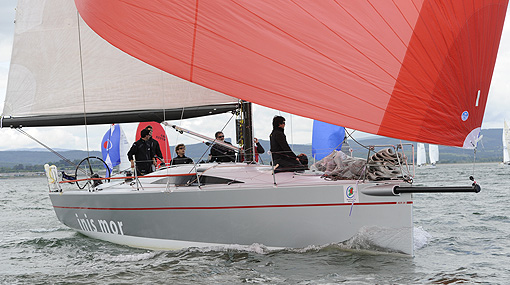
Bernard Gouy's Round Ireland winner Inismor, the winner of Afloat's International Sailor of the month award. Photo: Bob Bateman
However, their commitment to the Round Ireland race is nothing new. Before commissioning the present Inis Mor from designer Jason Ker, they campaigned a standard 40ft Jeanneau cruiser-racer and got into the frame. Their Round Ireland victory last weekend was the result of exemplary sailing and tactics throughout a very challenging race. It was textbook stuff, and we salute our International Award winners for showing the way.
#sailforgold – Peter O'Leary and David Burrows are wearing Gold tonight in Weymouth having won the most important pre-Olympic regatta of the season. They finished third in the Olympic Star class medal race to leap frog the Olympic and World champions raising further the expectation that the Cork-Dublin pair can deliver Ireland's first Olympic medal since 1980 in just under two months time.
The duo, who were fourth at last month's world championships in France performed consistently again this week staying in the top three in some of the toughest condtions of the season. Racing was cut short on Thursday when gales hit the Olympic venue.
The Irish Olympic bound pair were third overall heading in to this afternoon's medal race and a third place finish in the double points final this afternoon saw them jump ahead of Brazilian rivals Scheidt & Prada (BRA) and Brtiain's Olympic champions Percy and Simpson who were involved in a collision.
It is the second Gold for O'Leary in Weymouth he previously won with German crew Fritjof Kleen at Sail for Gold 2010.
Earlier today, in a big day for Irish sailing single hander Annalise Murphy took bronze in the Laser Radial and in the 49er class Ryan Seaton and Matt McGovern were seventh giving Ireland three medal possbilities at the Summer Olympics.


























